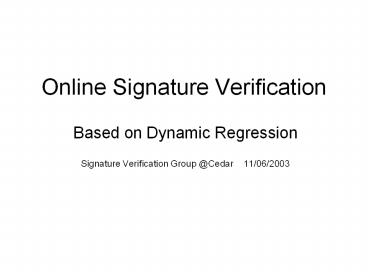Online Signature Verification - PowerPoint PPT Presentation
Title:
Online Signature Verification
Description:
On Pattern Analysis and Machine Intelligence, Vol. 25, No. 2, pp. 200-216, February 2003. References [6] Vishvjit S. Nalwa. Automatic On-line Signature Verification. – PowerPoint PPT presentation
Number of Views:234
Avg rating:3.0/5.0
Title: Online Signature Verification
1
Online Signature Verification
- Based on Dynamic Regression
- Signature Verification Group _at_Cedar 11/06/2003
2
Signature verification-gtBasic Procedure
- 1. Template generation
- In real application, the number of given genuine
signatures is very few (usually less than 6) and
no forgery is provided. - 2. Matching based on the template.
- Input one signature, output a
confidence(0-100) that the signature is genuine.
3
Signature verification-gt1. Template generation
- The challenges are
- 1).Very limited signatures for training.
- Usually we can not expect more than 6 genuine
signatures for training for each subject. This is
unlike handwriting recognition. - 2). Decide the consistent features.
- There are over 100 features for signature2,
such as Width, Height, Duration, Orientation, X
positions, Y positions, Speed, Curvature,
Pressure, so on.
4
Signature verification-gt1. Template generation
- We have following experience
- 1). The most reliable feature is the shape of
the signature. - 2). The second reliable feature is the speed of
writing. - 3). No other features are consistent.
- To represent shape and speed, each signature
is a 3-D sequence SigiXi, Yi, Vi, where Vi
is the sequence of speed magnitude. Then we use
Dynamic Regression to match two signatures and
return a Confidence of similarity (0-100).
5
Template Generation
- Features we choose
- Sequence of X Y
Genuine Sig.
X positions
Y positions
6
Template Generation
- Features comparison
X from genuine sig.
X from forgery sig.
Genuine sig.
Forgery sig.
7
Template Generation
- More features
- X, Y positions are not enough. We need spatial
features that describe the shape of the signature
curve. Torques, Curvature-ellipse are candidates
Torques of genuine sig.
Torques of forgery sig.
Now we can distinguish them !
8
Template Generation
- More features Curvature Ellipse
S1 of Curvature Ellipse (genuine)
S1 of Curvature Ellipse (forgery)
S2 of Curvature Ellipse (genuine)
S2 of Curvature Ellipse (forgery)
9
Template Generation
- Curve Matching Segmentation
10
Signature verification-gt2. Matching
- Traditional Simple Regression
Similarity 91
Similarity 31
11
Signature verification-gt2. Matching
- Traditional Simple Regression
- Advantages Invariant to scale and
translation Similarity (Goodness- of-fit)
makes sense. - Disadvantages One-one alignment, brittle.
One-One alignment
Dynamic alignment
12
Signature verification-gt2. Matching
- Dynamic Regression
( y2 is matched x2, x3, so we extend it to be two
points in Y sequence.)
The DTW warping path in the n-by-m matrix is the
path which has minimum average cumulative cost.
The unmarked area is the constrain that path is
allowed to go.
13
Signature verification-gtDemo System
Enroll two or more genuine signatures
14
Signature verification-gtDemo System
Verifying signature. Similarity is output and
Accept/Reject is recommended
15
Signature verification-gtRemarks
- Segmentation?
- Signature is an art of drawing, not limited to
some kind language. Segments by Perceptually
Important Points7 are by no means consistent
during genuine signature of one subject.
16
Signature verification-gtRemarks
- User-dependent distance threshold?
- Distance (Euclidean, DTW, etc.) for similarity
measure is so embarrassing. In real applications,
users tends to ask how similar is the two
signatures? Or, what is the confidence that this
signature is genuine? It is nature and friendly
to answer their similarity confidence is 90!
(instead of saying their distance of
dissimilarity is 5.8). Our demo system shows
that the answer by Dynamic Regression really
makes sense.
17
References
- 1 Rejean Plamondon, Guy Lorette. Automatic
Signature Verification and Writer
identification-the state of the art. Pattern
Recognition, Vol.22, No.2, pp.107-131, 1989. - 2 F. Leclerc and R. Plamondon. Automatic
signature verification the state of the art
1989-1993. International Journal of Pattern
Recognition and Artificial Intelligence,
8(3)643-660, 1994. - 3 Luan L. Lee, Toby Berger, Erez Aviczer.
Reliable On-line Human Signature Verifications
Systems. IEEE trans. On Pattern Analysis and
Machine Intelligence, Vol. 18, No.6, June 1996. - 4 R. Plamondon. The Design of On-line Signature
Verification System From Theory to Practice.
Intl J. Pattern Recognition and Artificial
Intelligence, vol. 8, no. 3, pp. 795-811, 1994. - 5 Mario E. Munich, Pietro Perona. Visual
Identification by Signature Tracking. IEEE Trans.
On Pattern Analysis and Machine Intelligence,
Vol. 25, No. 2, pp. 200-216, February 2003.
18
References
- 6 Vishvjit S. Nalwa. Automatic On-line
Signature Verification. Proceedings of the IEEE,
Vol. 85, No. 2, pp. 215-239, February 1997. - 7 Jean-Jules Brault and Rejean Plamondon.
Segmenting Hanwritten Signatures at Their
Perceptually Important Points. IEEE Trans. On
Pattern Analysis and Machine Intelligence, Vol,
15, No. 9, pp. 953-957, September 1993. - 8 Taik H. Rhee, Sung J. Cho, Jin H. Kim.
On-line Signature Verification Using Model-Guided
Segmentation and Discriminative Feature Selection
for Skilled Forgeries. Sixth International
Conference on Document Analysis and - Recognition (ICDAR '01), September, Seattle,
Washington, 2001. - 9 Thomas B. Sebastian, Philip N. Klein, Bejamin
B. Kimia. On Aligning Curves. IEEE Trans. On
Pattern Analysis and Machine Intelligence, Vol.
25, No. 1, January 2003. - 10 A.K. Jain, Friederike D. Griess and Scott D.
Connell. On-line Signature Verification. Pattern
Recognition, vol. 35, no. 12, pp. 2963--2972, Dec
2002.
19
References
- 11 K. Huang and H. Yan, On-Line Signature
Verification Based on Dynamic segmentation and
Global and Local Matching, Optical Eng., vol.
34, no. 12, pp. 3480-3487, 1995. - 12 G. Lorette and R. Plamondon, Dynamic
Approaches to Hand-written Signature
Verification, Computer Processing of
Hand-writing, pp. 21-47, 1990. - 13 R. Martens and L. Claesen, On-Line
Signature Verification by Dynamic Time-Warping,
Proc. 13th Intl Conf. Pattern Recognition, pp.
38-42, 1996. - 14 B. Wirtz, Stroke-Based Time Warping for
Signature Verification, Proc. Intl Conf.
Document Analysis and Recognition, pp. 179-182,
1995.































